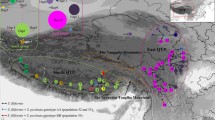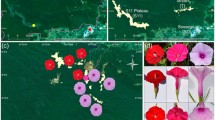Abstract
Revegetation using native species requires the development of seed transfer zones that capture genetic distinctiveness and adaptive potentials while avoiding potential maladaptation and genetic contamination by exotic genotypes. Delineation based on phylogeographic information has recently been used to establish seed transfer zones; however, only a few herbaceous species that are suitable for revegetation have been investigated in the temperate regions of Japan. We investigated the phylogeography of non-coding regions of chloroplast DNA of ten native species in the temperate regions of Japan. Although no species showed clear-cut geographical distributions of the 2–14 haplotypes identified, spatially constrained Bayesian clustering showed two clusters in five species (Calamagrostis epigejos, Eragrostis ferruginea, Imperata cylindrica, Microstegium japonicum, and Microstegium vimineum) but not for others. Posterior modes of clusters for I. cylindrica and M. vimineum showed delineations at Chubu (the middle of Honshu Island), which divide the study region into northeastern and southwestern regions, indicating that these species had recovered from glacial refugia. Posterior mode of cluster for E. ferruginea showed that one consists of a coastal zone along the Pacific Ocean side of western Japan, while the other consists of the remaining area, indicating range expansion from south coast to north. Delineation of C. epigejos and M. japonicum were unclear. The mixed results indicated that establishing seed transfer zones for herbaceous species in Japan will require phylogeographical studies on a wide range of species that may be suitable for revegetation.



Similar content being viewed by others
References
Aavik T, Edwards PJ, Holderegger R et al (2012) Genetic consequences of using seed mixtures in restoration: a case study of a wetland plant Lychnis flos-cuculi. Biol Conserv 145:195–204. doi:10.1016/j.biocon.2011.11.004
Azpilicueta MM, Gallo LA, van Zonneveld M et al (2013) Management of Nothofagus genetic resources: definition of genetic zones based on a combination of nuclear and chloroplast marker data. For Ecol Manage 302:414–424. doi:10.1016/j.foreco.2013.03.037
Bradley St Clair J, Kilkenny FF, Johnson RC et al (2013) Genetic variation in adaptive traits and seed transfer zones for Pseudoroegneria spicata (bluebunch wheatgrass) in the northwestern United States. Evol Appl 6:933–948. doi:10.1111/eva.12077
Bucci G, González-Martínez SC, Le Provost G et al (2007) Range-wide phylogeography and gene zones in Pinus pinaster Ait. revealed by chloroplast microsatellite markers. Mol Ecol 16:2137–2153. doi:10.1111/j.1365-294X.2007.03275.x
Clark LV, Stewart JR, Nishiwaki A et al (2015) Genetic structure of Miscanthus sinensis and Miscanthus sacchariflorus in Japan indicates a gradient of bidirectional but asymmetric introgression. J Exp Bot. doi:10.1093/jxb/eru511
Dray S, Dufour A-B, Thioulouse J (2015) Ade4: analysis of ecological data: exploratory and euclidean methods in environmental sciences. Available at: http://cran.r-project.org/package=ade4. Accessed 7 June 2016
Dvořáková H, Fér T, Marhold K (2010) Phylogeographic pattern of the European forest grass species Hordelymus europaeus: cpDNA evidence. Flora—Morphol Distrib Funct Ecol Plants 205:418–423. doi:10.1016/j.flora.2009.12.029
Environmental Agency of Japan (1997) The national land division for biodiversity conservation. Environmental Agency of Japan, Tokyo (In Japanese)
Escudero M, Vargas P, Valcárcel V, Luceño M (2008) Strait of Gibraltar: an effective gene-flow barrier for wind-pollinated Carex helodes (Cyperaceae) as revealed by DNA sequences, AFLP, and cytogenetic variation. Am J Bot 95:745–755. doi:10.3732/ajb.2007342
Evanno G, Regnaut S, Goudet J (2005) Detecting the number of clusters of individuals using the software STRUCTURE: a simulation study. Mol Ecol 14:2611–2620. doi:10.1111/j.1365-294X.2005.02553.x
Fujii N (2007) Chloroplast DNA phylogeography of Pedicularis ser. Gloriosae (Orobanchaceae) in Japan. J Plant Res 120:491–500. doi:10.1007/s10265-007-0083-2
Fujii N, Tomaru N, Okuyama K et al (2002) Chloroplast DNA phylogeography of Fagus crenata (Fagaceae) in Japan. Plant Syst Evol 232:21–33. doi:10.1007/s006060200024
Guillot G, Renaud S, Ledevin R et al (2012) A unifying model for the analysis of phenotypic, genetic, and geographic data. Syst Biol 61:897–911. doi:10.1093/sysbio/sys038
Hall T (2013) BioEdit v7.2.5: a user-friendly biological sequence alignment editor and analysis program for Windows 95/98/NT. Available at: http://www.mbio.ncsu.edu/bioedit/bioedit.html. Accessed 7 June 2016
Hamrick JL, Godt MJW, Sherman-Broyles SL (1992) Factors influencing levels of genetic diversity in woody plant species. New For 6:95–124
Hayakawa H, Aakasaka M, Shimono Y et al (2014) Phylogeography based on the nuclear ribosomal DNA internal transcribed spacer region of native Miscanthus sinensis (Poaceae) populations in Japan. Weed Biol Manag 14:251–261
Herget ME, Hufford KM, Mummey DL, Shreading LN (2015) Consequences of seed origin and biological invasion for early establishment in restoration of a North American grass species. PLoS One 10:e0119889. doi:10.1371/journal.pone.0119889
Iwasaki T, Aoki K, Seo A (2012) Comparative phylogeography of four component species of deciduous broad-leaved forests in Japan based on chloroplast DNA variation. doi: 10.1007/s10265-011-0428-8
Johnson LMK, Galloway LF (2008) From horticultural plantings into wild populations: movement of pollen and genes in Lobelia cardinalis. Plant Ecol 197:55–67. doi:10.1007/s11258-007-9359-9
Johnson R, Hellier B, Vance-Borland K (2013) Genecology and seed zones for tapertip onion in the US great Basin. Botany 91:686–694
Kira T (1977) A climatological interpretation of Japanese vegetation zones. In: Miyawaki A, Tüxen R (eds) Vegetation science and environmental protection. Maruzen, Tokyo, pp 21–30
Kramer AT, Larkin DJ, Fant JB (2015) Assessing potential seed transfer zones for five Forb species from the Great Basin Floristic Region, USA. Nat Areas J 35:174–188
Loveless M, Hamrick JL (1984) Ecological determinants of genetic structure in plant populations. Annu Rev Ecol Syst 15:65–95. doi:10.1146/annurev.ecolsys.15.1.65
Maekawa F (1943) Prehistoric-naturalized plants to Japan proper. Acta Phytotaxo Geobot 13:274–279 (In Japanese)
Matsumura M, Yukimura T (1980) The comparative ecology of intraspecific variants of the Chigaya, Imperata cylindrica var, koenigii (Alang-alang). (1) Habitats of the common and early flowering types of the Chigaya based on the vegetation characteristics. Res Bull Fac Agr Gifu Univ 43:233–248 (In Japanese)
McKay JK, Christian CE, Harrison S, Rice KJ (2005) “How local is local?”—A review of practical and conceptual issues in the genetics of restoration. Restor Ecol 13:432–440. doi:10.1111/j.1526-100X.2005.00058.x
Michalski SG, Durka W, Jentsch A et al (2010) Evidence for genetic differentiation and divergent selection in an autotetraploid forage grass (Arrhenatherum elatius). Theor Appl Genet 120:1151–1162. doi:10.1007/s00122-009-1242-8
Mizuguti et al (2004) Genetic difference between two types of Imperate cylindrica (L.) Beauv. characterized by flowering phenology. Grassl Sci 50:9–14
Nomura Y, Shimono Y, Tominaga T (2015) Development of chloroplast DNA markers in Japanese imperata cylindrica. Weed Res 55:329–333. doi:10.1111/wre.12149
Ohsawa T, Ide Y (2011) Phylogeographic patterns of highland and lowland plant species in Japan. Alp Bot 121:49–61. doi:10.1007/s00035-010-0083-z
Osada T (1989) Illustrated grasses of Japan. Heibonsha, Tokyo (In Japanese)
Paradis E, Jombart T, Schliep K et al (2015) Pegas: population and evolutionary genetics analysis system. Available at: http://cran.r-project.org/package=pegas. Accessed 7 June 2016
Petit RJ, Aguinagalde I, de Beaulieu J-L et al (2003) Glacial refugia: hotspots but not melting pots of genetic diversity. Science 300:1563–1565. doi:10.1126/science.1083264
Petit RJ, Duminil D, Fineschi S et al (2005) Comparative organization of chloroplast, mitochondrial and nuclear diversity in plant populations. Mol Ecol 14:689–701. doi:10.1111/j.1365-294X.2004.02410.x
Plummer M, Best N, Cowles K et al (2015) Coda: output analysis and diagnostics for MCMC. Available at: http://cran.r-project.org/package=coda. Accessed 7 June 2016
Pritchard JK, Stephens M, Donnelly P (2000) Inference of population structure using multilocus genotype data. Genetics 155:945–959. doi:10.1111/j.1471-8286.2007.01758.x
R Core Team (2015) R: a language and environment for statistical computing. R Foundation for Statistical Computing, Vienna, Austria. https://www.R-project.org/. Accessed 7 June 2016
Rejzková E, Fér T, Vojta J, Marhold K (2008) Phylogeography of the forest herb Carex pilosa (Cyperaceae). Bot J Linn Soc 158:115–130. doi:10.1111/j.1095-8339.2008.00826.x
Saltonstall K (2002) Cryptic invasion by a non-native genotype of the common reed, Phragmites australis, into North America. Proc Natl Acad Sci USA 99:2445–2449. doi:10.1073/pnas.032477999
Scarcelli N, Barnaud A, Eiserhardt W et al (2011) A set of 100 chloroplast DNA primer pairs to study population genetics and phylogeny in monocotyledons. PLoS One 6:e19954. doi:10.1371/journal.pone.0019954
Severns PM, Bradford E, Liston A (2013) Whole genome duplication in a threatened grassland plant and the efficacy of seed transfer zones. Divers Distrib 19:455–464. doi:10.1111/ddi.12004
Shimono Y, Hayakawa H, Kurokawa S et al (2013a) Phylogeography of mugwort (Artemisia indica), a native pioneer herb in Japan. J Hered 104:830–841. doi:10.1093/jhered/est054
Shimono Y, Kurokawa S, Nishida T et al (2013b) Phylogeography based on intraspecific sequence variation in chloroplast DNA of Miscanthus sinensis (Poaceae), a native pioneer grass in Japan. Botany 91:449–456. doi:10.1139/cjb-2012-0212
Sutkowska A, Pasierbiński A, Warzecha T, Mitka J (2014) Multiple cryptic refugia of forest grass Bromus benekenii in Europe as revealed by ISSR fingerprinting and species distribution modelling. Plant Syst Evol 300:1437–1452. doi:10.1007/s00606-013-0972-x
Taberlet P, Gielly L, Pautou G, Bouvet J (1991) Universal primers for amplification of three non-coding regions of chloroplast DNA. Plant Mol Biol 17:1105–1109. doi:10.1007/BF00037152
The Geneland Development Group (2012) Population genetic and morphometric data analysis using R and the Geneland program. Available at: http://cran.r-project.org/package=Geneland. Accessed 7 June 2016
Tominaga T, Kobayashi H, Ueki K (1990) Adaptive differentiation to local populations of Imperata cylindrica in Japan. J Trop Agric 34:250–254
Tsuda S, Kobayashi S, Tomita M et al (2014) Phylogeographic study of 10 herbaceous plants native in Japan based on intraspecific chloroplast DNA variation. J Jpn Soc Reveg Technol 40:72–77 (In Japanese)
Vander Mijnsbrugge K, Bischoff A, Smith B (2010) A question of origin: where and how to collect seed for ecological restoration. Basic Appl Ecol 11:300–311
Wilson B, Darris D, Fiegener R (2008) Seed transfer zones for a native grass Festuca roemeri: genecological evidence. Nativ Plants 9:287–302
Wolfe KH, Li WH, Sharp PM (1987) Rates of nucleotide substitution vary greatly among plant mitochondrial, chloroplast, and nuclear DNAs. Proc Natl Acad Sci USA 84:9054–9058. doi:10.1073/pnas.84.24.9054
Yasuda K, Shibayama H (2003) Geographical distribution of chloroplast DNA variation of cogongrass (Imperata cylinfrica) in Japan. Coast Environ 2:51–58 (In Japanese)
Acknowledgments
We thank Rikyu Matsuki and Chinami Ishiyama for their assistance in field sampling and laboratory works. We are also grateful to two anonymous reviewers for comments on previous versions of the manuscript. The study was funded by an in-house budget of the Central Research Institute of Electric Power Industry and Chubu Electric Power. All the experiments comply with the current laws of Japan.
Author information
Authors and Affiliations
Corresponding author
Electronic supplementary material
Below is the link to the electronic supplementary material.
Rights and permissions
About this article
Cite this article
Tomita, M., Kobayashi, S., Abe, S. et al. Phylogeography of ten native herbaceous species in the temperate region of Japan: implication for the establishment of seed transfer zones for revegetation materials. Landscape Ecol Eng 13, 33–44 (2017). https://doi.org/10.1007/s11355-016-0297-3
Received:
Revised:
Accepted:
Published:
Issue Date:
DOI: https://doi.org/10.1007/s11355-016-0297-3




